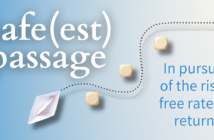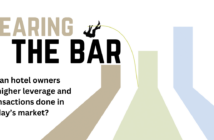by Rushi Shah
Achieving financial security is a common goal for most everyone. The path we take to get there, our tolerance for risk along the way, potential reward in exchange for the risk we take, and how we determine when we’ve arrived, however, vary widely. For hotel and commercial real estate owners, financial security is more than accumulating wealth. In this industry, financial security is the financial freedom to do what you want without worrying about future threats, or “handicapping the downside.” One of the best ways to achieve financial freedom is to choose the right financing strategy that insulates your personal wealth from unnecessary risk and positions your portfolio for opportunistic growth.
THE ONLY THING CERTAIN IS UNCERTAINTY
We talk to a lot of hotel and other commercial real estate owners who believe they already have secured their financial future, and as a result ignore opportunities to improve their situation or myopically focus on saving money today at the expense of uncalculated risks in the future. Recourse, or the risk on borrowing debt, is a key concept that is frequently in an owner’s blind spot. It also is core to one of the most mispriced elements in the calculation of revenues and expenses – contingent liability. Contingent liability is any real or theoretical liability that is not a liability today but could become a real financial liability in the future. Even though they are not currently a risk, because there is potential for them to be an issue in the future, contingent liabilities must appear on owners’ personal financial statements.
Banks and credit committees at every financial institution in the business of lending money pay close attention to the number and severity of contingent liabilities. They know from experience that in times of market or systemic distress, what is now theory can quickly morph into reality. Hotel and commercial real estate owners are particularly scrutinized, as they tend to have highly correlated and less-diversified portfolio holdings. As a result, when the market shifts, all asset classes on an owner’s balance sheet move in the same direction. This creates a viral or contagion effect to the overall financial security of once-well-heeled property owners.
ACCURATELY PRICING THE VALUE OF RECOURSE RISK
Hotel and commercial real estate owners’ ability to make the right financial decision is often skewed by what is known as institutional memory, or the tendency to forget about what perils a financial downturn can bring to their personal financial security. An extended recovery and expansion in the economy often contribute to this lack of hindsight and cause owners to grossly misprice the value of recourse risk. A more-prudent pricing approach looks at recourse risk from the perspective of two key components. The first is the monetary component that results from the spread. The second is the structuring and servicing of the loan.
MONETARY COMPONENT
The monetary component is strictly calculated in the form of a rate premium. According to a study done by one of the top London-based insurance clearinghouses, recourse insurance or personal-guarantee insurance should cost 2 percent per year on the interest rate. Using this benchmark and with all else being equal, a non-recourse loan should be priced at a 2-percent-higher interest rate than its full recourse counterpart. In today’s environment, however, most non-recourse loans are actually pricing below that of a full personal-guarantee loan for all asset types and particularly for hotels. There are two theories behind this discrepancy. On the one hand, it can be attributed to market demand. Because non-recourse loans carry additional structuring and typically include pre-payment penalties, owners are not willing to pay a premium to take on the debt, despite the minimized risk benefits. On the other hand, it could be a symptom of higher costs, as banks must price full-recourse loans higher in order to cover extensive regulatory and compliance expenses, especially for hotel loans.
STRUCTURING & SERVICING COMPONENT
Most lenders sell servicing rights for non-recourse loans to a third-party servicer as it is typically more cost effective than managing it in house and servicing is not the highest and best use of their resources. This practice, along with additional loan structuring the lender may mandate in order to protect its interests, can sour owner appetite for non-recourse options and cause them to overlook the benefits. It is important to understand the why behind these perceived disadvantages. Lenders must require the additional layers of protection because they have no other recourse against a borrower in the event of default. For example, we recently closed a $13-million deal for a hotel. As part of the transaction, the owner was able to cash out $7 million, which he used to build two new hotels in the same parking lot adjacent to his existing hotel. The lender was willing to offer a non-recourse loan because of our close relationship but required additional structuring to prevent the owner from directing business from the collateral hotel to the new hotel. Per the loan parameters, if the owner was caught doing so, the owner would be on the hook for any losses arising from it. This type of structuring was only an option because it was a non-recourse loan and was the only way in the current market landscape for the owner to achieve the high level of leverage he wanted at a fairly low interest rate. Some owners would view this added structuring as a nuisance and deal-breaker for pursuing non-recourse debt. In the current market environment, however, being able to lock in a long-term loan at a high loan-to-value and at a relatively low interest rate without recourse, compared to a higher-rate conventional loan burdened by personal guarantees, more than justifies these perceived risks.
SETTING EMOTIONS ASIDE
Hotel and other commercial real estate owners who have worked hard to achieve what they consider financial security often let their emotions cloud their decision-making process. They may rationalize that there is no value in non-recourse debt because they know how to run their business and are never going to default. While this spirt and integrity is to be commended, no one ever enters into a financial transaction with the explicit or implicit intention for it to fail. Smart owners, who want to achieve true financial security or freedom, are willing to look past their pride and focus on what is best for their future and their legacy. They understand the benefits of working with an expert intermediary to evaluate, negotiate, and structure the most strategic financing solution that insulates them from unnecessary risk and positions them for ongoing success.
 Rushi Shah is principal and CEO of the commercial mortgage and real estate investment banking firm and AAHOA Club Blue Member Mag Mile Capital. As a leader in hospitality financing, Shah specializes in structuring and placing high-leverage, non-recourse bridge and permanent debt with cash out for full- and limited-service hotels nationwide. Since joining the firm’s predecessor, Aries Capital, in 2015, Shah has structured and closed hundreds of millions in financing for all property types. Shah has held previous positions at Northern Trust and has an MBA from the University of Chicago’s Booth School of Business.
Rushi Shah is principal and CEO of the commercial mortgage and real estate investment banking firm and AAHOA Club Blue Member Mag Mile Capital. As a leader in hospitality financing, Shah specializes in structuring and placing high-leverage, non-recourse bridge and permanent debt with cash out for full- and limited-service hotels nationwide. Since joining the firm’s predecessor, Aries Capital, in 2015, Shah has structured and closed hundreds of millions in financing for all property types. Shah has held previous positions at Northern Trust and has an MBA from the University of Chicago’s Booth School of Business.




